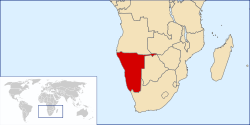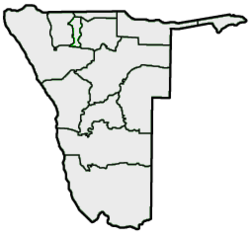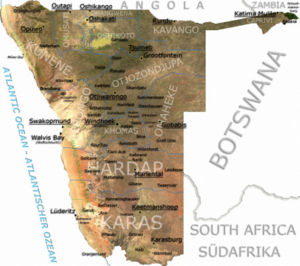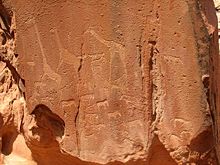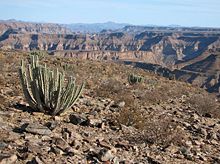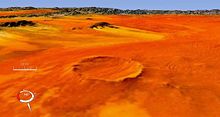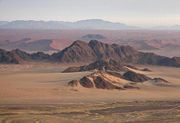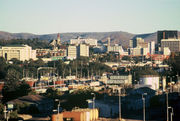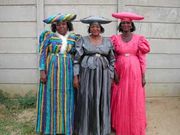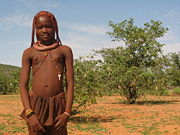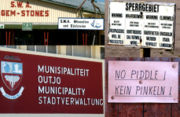Namibia
2008/9 Schools Wikipedia Selection. Related subjects: Africa; African Countries
| Republic of Namibia | ||||||
|---|---|---|---|---|---|---|
|
||||||
| Motto: "Unity, Liberty, Justice" | ||||||
| Anthem: Namibia, Land of the Brave |
||||||
|
|
||||||
| Capital (and largest city) |
Windhoek |
|||||
| Official languages | English1 | |||||
| Recognised regional languages | German, Afrikaans, Oshiwambo | |||||
| Demonym | Namibian | |||||
| Government | Republic | |||||
| - | President | Hifikepunye Pohamba | ||||
| - | Prime minister | Nahas Angula | ||||
| Independence | from South Africa | |||||
| - | Date | March 21, 1990 | ||||
| Area | ||||||
| - | Total | 825,418 km² ( 34th) 318,696 sq mi |
||||
| - | Water (%) | negligible | ||||
| Population | ||||||
| - | July 2005 estimate | 1,820,9162 ( 144th) | ||||
| - | 2002 census | 1,820,916 | ||||
| - | Density | 2.5/km² ( 225th) 6.5/sq mi |
||||
| GDP ( PPP) | 2005 estimate | |||||
| - | Total | $15.14 billion ( 123rd) | ||||
| - | Per capita | $7,478 ( 77th) | ||||
| Gini (2003) | 70.7 (high) ( 1st) | |||||
| HDI (2007) | ▲ 0.650 (medium) ( 125th) | |||||
| Currency | Namibian dollar ( NAD) |
|||||
| Time zone | WAT ( UTC+1) | |||||
| - | Summer ( DST) | WAST ( UTC+2) | ||||
| Internet TLD | .na | |||||
| Calling code | +264 | |||||
| 1 German and Afrikaans were official languages until independence in 1990. The majority of the population speaks Afrikaans as a second language, while Oshiwambo is the first language of approximately half the population. German is spoken by 32% of the European community whereas English is only spoken by 7%. Estimates for this country explicitly take into account the effects of excess mortality due to AIDS; this can result in lower life expectancy, higher infant mortality and death rates, lower population and growth rates, and changes in the distribution of population by age and sex than would otherwise be expected. | ||||||
Namibia, officially the Republic of Namibia, is a country in southern Africa on the Atlantic coast. It shares borders with Angola and Zambia to the north, Botswana to the east, and South Africa to the south. It gained independence from South Africa in 1990 and its capital city is Windhoek (German: Windhuk). Namibia is a member state of the United Nations (UN), the Southern African Development Community (SADC), the African Union (AU), and the Commonwealth of Nations. It is named after the Namib Desert.
History
The dry lands of Namibia were inhabited since early times by Bushmen, Damara, Namaqua, and since about the 14th century AD, by immigrating Bantu who came with the Bantu expansion. The region was not extensively explored by Europeans until the 19th century. Namibia became a German colony and was known as German South-West Africa (Deutsch-Südwestafrika) — apart from Walvis Bay, which was under British control. South Africa occupied the colony during World War I and administered it as a League of Nations mandate territory until after World War II, when it unilaterally annexed the territory, without international recognition.
In 1966, the South-West Africa People's Organisation (SWAPO) military wing, People's Liberation Army of Namibia, a guerrilla group launched a war of independence, but it was not until 1988 that South Africa agreed to end its administration of Namibia, in accordance with a United Nations peace plan for the entire region. Independence came in 1990, and Walvis Bay was ceded to Namibia in 1994 upon the end of Apartheid in South Africa.
Regions and constituencies
Namibia is divided into 13 regions and subdivided into 102 constituencies.
Geography
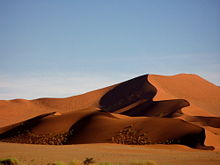
At 825.418 km² (318.7 sq mi), Namibia is the world's thirty-fourth largest country (after Venezuela). After Mongolia, Namibia is the least densely populated country in the world (2.5 inhabitants per square kilometre (6.5 /sq mi)).
The Namibian landscape consists generally of five geographical areas, each with characteristic abiotic conditions and vegetation with some variation within and overlap between them: the Central Plateau, the Namib Desert, the Escarpment, the Bushveld, and the Kalahari Desert. Although the climate is generally extremely dry, there are a few exceptions. The cold, north-flowing Benguela current accounts for some of the low precipitation.
The Central Plateau runs from north to south, bordered by the Skeleton Coast to the north west, the Namib Desert and its coastal plains to the south west, the Orange River to the south, and the Kalahari Desert to the east. The Central Plateau is home to the highest point in Namibia at Königstein elevation 2,606 meters (8,550 ft). Within the wide, flat Central Plateau is the majority of Namibia’s population and economic activity. Windhoek, the nation’s capital, is located here, as well as most of the arable land. Although arable land accounts for only 1% of Namibia, nearly half of the population is employed in agriculture.
The abiotic conditions here are similar to those found along the Escarpment, described below; however the topographic complexity is reduced. Summer temperatures in the area can reach 40°C during the summer, and in the winter, frosts are common.
The Namib Desert is a broad expanse of hyper-arid gravel plains and dunes that stretches along the entire coastline, which varies in width between 100 to many hundreds of kilometres. Areas within the Namib include the Skeleton Coast and the Kaokoveld in the north and the extensive Namib Sand Sea along the central coast. The sands that make up the sand sea are a consequence of erosional processes that take place within the Orange River valley and areas further to the south. As sand-laden waters drop their suspended loads into the Atlantic, onshore currents deposit them along the shore. The prevailing south west winds then pick up and redeposit the sand in the form of massive dunes in the widespread sand sea. In areas where the supply of sand is reduced because of the inability of the sand to cross riverbeds, the winds also scour the land to form large gravel plains. In many areas within the Namib Desert, there is little vegetation with the exception of lichens found in the gravel plains, and in dry river beds where plants can access subterranean water.
The Great Escarpment swiftly rises to over 2,000 meters (6,562 ft). Average temperatures and temperature ranges increase as you move further inland from the cold Atlantic waters, while the lingering coastal fogs slowly diminish. Although the area is rocky with poorly developed soils, it is nonetheless significantly more productive than the Namib Desert. As summer winds are forced over the Escarpment, moisture is extracted as precipitation. The water, along with rapidly changing topography, is responsible for the creation of microhabitats which offer a wide range of organisms, many of them endemic. Vegetation along the Escarpment varies in both form and density, with community structure ranging from dense woodlands to more shrubby areas with scattered trees. A number of Acacia species are found here, as well as grasses and other shrubby vegetation.
The Bushveld is found in north eastern Namibia along the Angolan border and in the Caprivi Strip which is the vestige of a narrow corridor demarcated for the German Empire to access the Zambezi River. The area receives a significantly greater amount of precipitation than the rest of the county, averaging around 400 millimetres per year. Temperatures are also cooler and more moderate, with approximate seasonal variations of between 10 °C (50 °F) and 30 °C (90 °F). The area is generally flat and the soils sandy, limiting their ability to retain water. Located adjacent to the Bushveld in north-central Namibia is one of nature’s most spectacular features: the Etosha Pan. For most of the year it is a dry, saline wasteland, but during the wet season, it forms a shallow lake covering more than 6000 square kilometres. The area is ecologically important and vital to the huge numbers of birds and animals from the surrounding savannah that gather in the region as summer drought forces them to the scattered waterholes that ring the pan.
The Kalahari Desert is perhaps Namibia’s best known geographical feature. Shared with South Africa and Botswana, it has a variety of localized environments ranging from hyper-arid sandy desert, to areas that seem to defy the common definition of desert. One of these areas, known as the Succulent Karoo, is home to over 5,000 species of plants, nearly half of them endemic; fully one third of the world’s succulents are found in the Karoo.
The reason behind this high productivity and endemism may be the relatively stable nature of precipitationThe Karoo apparently does not experience drought on a regular basis, so even though the area is technically desert, regular winter rains provide enough moisture to support the region’s interesting plant community. Another feature of the Kalahari, indeed many parts of Namibia, are Inselbergs, isolated mountains that create microclimates and habitat for organisms not adapted to life in the surrounding desert matrix.
Besides the capital city Windhoek in the centre of the country, other important towns are the ports of Walvis Bay and Swakopmund, as well as Oshakati and Grootfontein.
Economy
Namibia’s economy consists primarily of mining and manufacturing which represent 8% of the Gross Domestic Product (GDP) respectively. Namibia has a 30-40% unemployment rate and recently passed a 2004 labour act to protect people from job discrimination stemming from pregnancy and HIV/AIDS status. Namibia’s economy is tied closely to South Africa’s due to their shared history. The Central Plateau serves as a transportation corridor from the more densely populated north to South Africa, the source of four-fifths of Namibia’s imports. Namibia is the fourth largest exporter of non-fuel minerals in Africa and the world's fifth largest producer of uranium. There has been significant investment in uranium mining and Namibia is set to become the largest exporter of uranium by 2015. Rich alluvial diamond deposits make Namibia a primary source for gem-quality diamonds. Namibia also produces large quantities of lead, zinc, tin, silver, and tungsten. About half of the population depends on agriculture (largely subsistence agriculture) for its livelihood, but Namibia must still import some of its food. Although per capita GDP is five times the per capita GDP of Africa's poorest countries, the majority of Namibia's people live in rural areas and exist on a subsistence way of life. Namibia has one of the highest rates of income inequality in the world, due in part to the fact that there is an urban economy and a more rural cash-less economy. The inequality figures thus take into account people who do not actually rely on the formal economy for their survival. Agreement has been reached on the privatisation of several more enterprises in coming years, with hopes that this will stimulate much needed foreign investment. However, reinvestment of environmentally derived capital has hobbled Namibian per capita income. One of the fastest growing areas of economic development in Namibia is the growth of wildlife conservancies. These conservancies are particularly important to the rural generally unemployed population.
Child labour occurs in Namibia, and key stakeholders including government ministries endorsed the Action Programme towards the Elimination of Child Labour in January 2008.
Tourism
Namibia generally attracts eco-tourists with the majority visiting to experience the different climates and natural geographical landscapes such as the great eastern desert and plains. There are many lodges and reserves to accommodate eco-tourists.
The most visited regions include, although are not limited to, the Sossosvlei, Etosha Park and the coastal activity areas of Swakopmund and Walvis Bay.
Language
Until 1990,the official languages were German, Afrikaans and English.
When Namibia became independent of South Africa, the new Namibian government wanted to avoid accusations of preferential treatment for either the Afrikaans- or the German-speaking groups. Therefore, English became the sole official language of Namibia. German, Afrikaans and Oshiwambo became recognised regional languages.
German is the native language of 30,000 Germans living in Namibia. It is also spoken as a second language by a large group of the white population. A part of the black population also speak German as a second language, although it is used primarily for trading purposes.
Politics
The politics of Namibia takes place in a framework of a presidential representative democratic republic, whereby the President of Namibia is elected to a five year term and is both the head of state and the head of government, and of a multi-party system. Executive power is exercised by the government. Legislative power is vested in both the government and the bicameral Parliament, the National Assembly and the National Council. The Judiciary is independent of the executive and the legislature.
Communal Wildlife Conservancies
Namibia is the only country in the world to specifically address conservation and protection of natural resources in its constitution. Article 95 states, “The State shall actively promote and maintain the welfare of the people by adopting international policies aimed at the following: maintenance of ecosystems, essential ecological processes, and biological diversity of Namibia, and utilization of living natural resources on a sustainable basis for the benefit of all Namibians, both present and future.”
In 1993, the newly formed government of Namibia received funding from the United States Agency for International Development (USAID) through its Living in a Finite Environment (LIFE) Project. The Ministry of Environment and Tourism with the financial support from organizations such as USAID, Endangered Wildlife Trust, WWF, and Canadian Ambassador’s Fund, together form a Community Based Natural Resource Management (CBNRM) support structure. The main goal of this project is promote sustainable natural resource management by giving local communities rights to wildlife management and tourism. Namibia is home to the African bull snake
Sports
The most popular sport in Namibia is association football (soccer). Rugby union and cricket are also popular. Namibia were participants in the 1999, 2003 and 2007 Rugby World Cups. They also played in the 2003 Cricket World Cup.
Demographics
Among the sovereign countries with the lowest population density, Namibia lies in second place, after Mongolia. The majority of the Namibian population is Black African — mostly of the Ovambo ethnicity, which forms about half of the population — and concentrated in the north of the country. There are also the Herero and Himba people who speak a similar language. In addition to the Bantu majority, there are large groups of Khoisan (e.g. Nama and Bushmen), who are descendants of the original inhabitants of Southern Africa. Khoisan differ significantly in appearance from both Bantu and White Africans. Blacks of other Bantu descent are descendants of refugees from Angola. There are also two smaller groups of people with mixed racial origins, called " Coloureds" and " Basters", who together make up 8% (with the Coloureds outnumbering the Basters two to one). Whites of Portuguese, Dutch, German, British and French ancestry make up about 5% of the population (about 85,000) — which is the second largest proportion and number in sub-Saharan Africa, after South Africa. Most of Namibian whites and nearly all those of mixed race are Afrikaans speakers and share similar origins, culture, religion and genealogy as the white and coloured populations of neighbouring South Africa. A smaller proportion of whites (around 13,000) trace their family origins directly back to German settlers and maintain German cultural and educational institutions. Nearly all Portuguese are miners and settlers from their former colony of Angola.
Half of all Namibians speak Oshiwambo as their first language, whereas the most widely understood languages are Afrikaans and German. Among the younger generation, the most widely understood language is English.
Both Afrikaans and English are used primarily as a second language reserved for public sphere communication, but small first language groups exist throughout the country. While the official language is English, most of the white population speaks either Afrikaans or German, both official languages until 1990 when Namibia became independent. Portuguese is spoken by blacks and whites from Angola.
Religion
Christianity is the major religion, with the Lutheran Church being the largest then followed by the Roman Catholic. The government of Namibia puts the number of people who practice Islam in Namibia at about 70,000 or about 3% of the population of Namibia. The Namaqua ethnic group makes up the largest group in Namibia's Muslim community.
HIV / AIDS in Namibia
The AIDS epidemic is a very large problem in Namibia as the country's infection rate is one of the highest on the continent and it shares its eastern border with Botswana which has the second highest rate of over 24%. In 2001, there were an estimated 210,000 people living with HIV/AIDS, and the estimated death toll in 2003 was 16,000. In north and central Namibia, malaria is also a pressing problem. The malaria problem seems to be compounded by the epidemic. Research has shown in Namibia, that the risk of contracting malaria is 14.5% greater if a person is also infected with HIV. The risk of death from malaria is also raised by approximately 50% with a concurrent HIV infection. Given infection rates this large as well as a looming malaria problem, it may be very difficult for the government to deal with both the medical and economic impacts of this epidemic.
Foreign relations
Namibia follows a largely independent foreign policy, with lingering affiliations with states that aided the independence struggle, including Libya and Cuba.
With a small army and a fragile economy, the Namibian Government's principal foreign policy concern is developing strengthened ties within the Southern African region. A dynamic member of the Southern African Development Community, Namibia is a vocal advocate for greater regional integration.
Namibia became the 160th member of the United Nations on April 23, 1990. On its independence it became the fiftieth member of the Commonwealth of Nations.
The Reporters Without Borders' Worldwide Press Freedom Index 2007 ranks Namibia as 25th out of 169 countries, as compared with 56th out of 166 in 2003, and 31st out of 139 in 2002.
International disputes
Namibia is involved in several minor international disputes, including:
- Small residual disputes with Botswana along the Caprivi Strip, including the Situngu marshlands and specifically Kasikili or Sedudu Island.
- A dormant dispute over where the boundaries of Botswana, Namibia, Zambia and Zimbabwe converge.
- Disputes over Angolan rebels and refugees residing in Namibia.
Military
The constitution of Namibia defined the role of the military as "defending the territory and national interests." Namibia formed the National Defence Force (NDF), comprising former enemies in a 23-year bush war: the People's Liberation Army of Namibia (PLAN) and South West African Territorial Force ( SWATF). The British formulated the force integration plan and began training the NDF, which consists of five battalions and a small headquarters element. The United Nations Transitional Assistance Group (UNTAG)'s Kenyan infantry battalion remained in Namibia for three months after independence to assist in training the NDF and stabilize the north. According to the Namibian Defence Ministry, enlistments of both men and women will number no more than 7,500. Defence and security account for approximately 3.7% of government spending.


